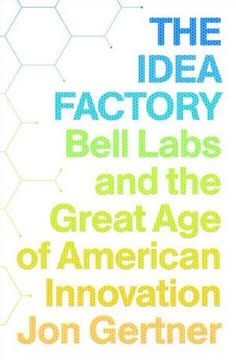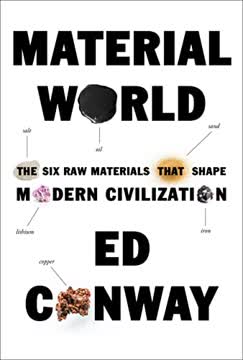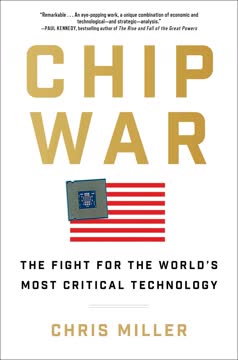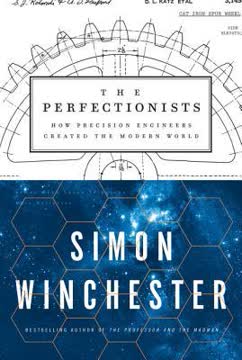Key Takeaways
1. Precision and Accuracy: A Fundamental Distinction
In summary, accuracy is true to the intention; precision is true to itself.
Defining terms. While often used interchangeably, precision and accuracy hold distinct meanings, especially in engineering. Accuracy refers to how close a measurement or action is to the true or desired value. Precision, conversely, describes the degree of refinement in a specification or the consistency of repeated measurements, regardless of their closeness to the true value.
Target analogy. The difference is best illustrated with a target. If all shots hit the bull's-eye and are clustered tightly, there is both accuracy and precision. However, if shots are tightly clustered but far from the bull's-eye, there is high precision but low accuracy. Conversely, shots scattered widely across the target, even if some hit the bull's-eye, demonstrate high accuracy (on average) but low precision.
Real-world implications. This distinction is crucial in fields ranging from manufacturing to science. A precisely made part might consistently be 0.1mm too long, showing high precision but low accuracy against the design specification. Understanding this difference allows engineers to identify and correct systemic errors, ensuring that products are not only consistently made but also correctly made to their intended design.
2. The Birth of Industrial Precision: Steam and Cylinders
Precision’s birth derives from the then-imagined possibility of maybe holding and managing and directing this steam, this invisible gaseous form of boiling water, so as to create power from it, and to demand that by the employment of this power, it perform useful work for the good (perhaps, and with luck) of all humankind.
Wilkinson's breakthrough. The concept of reproducible mechanical precision was born in 1776 with John Wilkinson, an English ironmaster. He developed a revolutionary technique for boring perfectly straight and true cylinders, initially for cannons, then crucially for James Watt's steam engines. This innovation allowed for a minimal gap between the piston and cylinder, preventing steam leakage and dramatically improving engine efficiency.
Watt's challenge. James Watt's early steam engines were plagued by inefficiency due to steam leakage from poorly bored cylinders. Despite his meticulous nature, traditional methods of hammering and forging iron sheets resulted in uneven gaps, requiring crude sealants like linseed oil–soaked leather or even horse dung. Wilkinson's method of boring solid iron cylinders, rather than hollow ones, provided the solution.
A new standard. Wilkinson's technique, which involved rotating a solid iron cylinder against a fixed, rigid cutting tool, achieved an unprecedented tolerance of one-tenth of an inch (or even 0.05 inches). This level of exactitude, previously unimaginable, transformed Watt's "fire-engine" into a powerful, efficient machine, formally marking the beginning of the Industrial Revolution and establishing a measurable, repeatable standard for mechanical precision.
3. Machine Tools Revolutionized Manufacturing and Interchangeable Parts
The machines that Maudslay made would, in other words, make the necessary parts with precision.
Maudslay's legacy. Henry Maudslay, initially an apprentice to Joseph Bramah, became a foundational figure in precision engineering by creating machine tools capable of producing parts with unprecedented exactitude. His innovations, particularly the all-iron lathe with a slide rest, allowed for the efficient and precise cutting of metal components, including standardized screws. This marked a shift from individual craftsmanship to machine-driven consistency.
Bramah's lock challenge. Maudslay's early work involved manufacturing Bramah's complex, supposedly unpickable locks. To meet demand and ensure consistency, Maudslay designed specialized machine tools for cutting slots, holding bolts, and winding springs. This approach ensured that each lock component was made identically, a crucial step towards interchangeable parts.
Portsmouth Block Mills. Maudslay's most significant contribution to mass production was designing and building 43 precision machines for the Royal Navy's Portsmouth Block Mills. These machines, powered by a Boulton and Watt steam engine, transformed felled elm trees into 130,000 pulley blocks annually, each identical and interchangeable. This factory, requiring only ten operators, demonstrated the profound social and economic impact of precision machinery, displacing skilled craftsmen but ensuring consistent supply.
4. Mass Production Demands Absolute Precision for Affordability
I will build a motor car for the great multitude.
Ford's vision. Henry Ford, unlike Henry Royce who aimed for perfection for the few, sought to make personal motor transport accessible to the masses. His Model T, launched in 1908, embodied this vision by being affordable, simple to maintain, and built from the best materials using the most efficient designs. This required a radical rethinking of manufacturing processes, moving beyond traditional craftsmanship.
The assembly line. Ford's most transformative innovation was the industrial production line, inspired by observing pig butchery. Instead of workers building a car from start to finish, the workpiece moved along a conveyor, with each worker performing a single, repetitive, precisely defined task. This system drastically reduced assembly time:
- Magneto assembly: from 20 minutes to 5 minutes.
- Axle assembly: from 2.5 hours to 26 minutes.
- Engine construction: from 10 hours to 4 hours.
Precision for efficiency. The assembly line's success hinged on absolute precision in every component. If a single part was not exact, it would halt the entire line, causing costly delays. This forced Ford to demand cruelly exacting tolerances for all parts, ensuring they were perfectly interchangeable without any need for filing or adjustment. This relentless pursuit of precision, aided by Carl Edvard Johansson's gauge blocks, allowed the Model T's price to plummet from $850 to $260, making it ubiquitous and transforming society.
5. Extreme Precision is Paramount for Aviation Safety
Any departure from absolute perfection could have the potential for the gravest and most disastrous of consequences—as the world came to know just a few minutes after 10:00 a.m. on the sunny Singapore morning of Thursday, November 4, 2010.
The Qantas 32 incident. The near-catastrophic failure of a Rolls-Royce Trent 900 jet engine on Qantas Flight 32 in 2010 starkly illustrated the critical role of extreme precision in aviation. A tiny, improperly machined oil feed stub pipe, only 5cm long, was half a millimeter too thin in one section. This minuscule flaw led to metal fatigue, rupture, and an "uncontained engine rotor failure" a mile above Indonesia.
Engine design challenges. Modern jet engines are marvels of engineering, operating in environments of extreme heat and pressure. High-pressure turbine blades, for instance, generate power equivalent to a Formula One car while operating in gases hotter than their melting point. Their survival depends on:
- Being made from single-crystal titanium alloys for immense strength.
- A network of precisely drilled cooling tunnels and pinholes that create a protective film of cooler air.
Human limitations. The Qantas 32 investigation revealed that despite rigorous quality control, human error in machining and inspection allowed the flawed part to enter service. This incident highlighted a critical juncture where the demands of modern precision in safety-critical industries might begin to outstrip human capabilities, necessitating increased automation. The manager of manufacturing at Rolls-Royce noted, "no human is going to produce the same quality of work at the end of a shift as they do at the beginning."
6. Hubble's Flawed Mirror: A Cautionary Tale of Optical Precision
The eight-foot-diameter primary mirror of the telescope, though at the time the most precisely made optical mirror ever built, appeared to have had its edges ground too flat.
A monumental failure. The Hubble Space Telescope, launched in 1990, was designed to provide unprecedented views of the cosmos. However, initial images were disastrously blurry, a "total deflation" for astronomers. The culprit: the primary mirror, though polished to an astonishing smoothness, was ground with edges 2.2 microns (one-fiftieth the thickness of a human hair) too flat, rendering most observations useless.
The human error. The flaw originated from a series of seemingly trivial human errors at Perkin-Elmer Corporation, the mirror's manufacturer. A critical measuring tool, a "null corrector," was itself inaccurate due to:
- A worn patch of non-reflective coating on a metering rod, causing a laser to focus 1.3mm too high.
- Technicians inserting three household washers to compensate for the perceived error, unknowingly cementing the inaccuracy.
The engineers, trusting the laser's "infallibility," precisely manufactured a perfectly wrong mirror.
Redemption in space. The Hubble's story is one of redemption. A daring space mission in 1993, STS-61, installed corrective optics (COSTAR) designed by Jim Crocker, who conceived the idea in a hotel shower. These "contact lenses" refocused the light, transforming Hubble into the most successful scientific instrument ever made, sending back tens of thousands of captivating, razor-sharp images of the universe.
7. GPS: Unprecedented Precision in Location and Timekeeping
From the position of the satellite, one could compute the exact position back on Earth of the person or machine that observed it.
Sputnik's unexpected legacy. The concept of satellite navigation emerged from two Johns Hopkins scientists, William Guier and George Weiffenbach, who in 1957 used the Doppler effect to precisely track the Soviet Sputnik satellite. Their work led Frank McClure to realize the inverse: if a satellite's position could be known, an observer's position on Earth could be determined from its signals.
Evolution of navigation. This insight led to the U.S. Navy's Transit system in the 1960s, providing ships with location accuracy within hundreds of feet. However, the need for greater precision, speed, and security for military applications, particularly nuclear submarines, spurred further innovation. Roger Easton's clock-difference navigation system, demonstrating location determination by measuring signal travel time from multiple sources, ultimately became the foundation for GPS.
Time underpins everything. The Global Positioning System (GPS), managed by the U.S. Air Force, relies on a constellation of 31 satellites, each carrying highly accurate atomic clocks. By comparing the "time of transmission" from multiple satellites with the "time of arrival" at a receiver, the system triangulates a user's position to within a few meters (or millimeters for surveyors). This unprecedented precision in timekeeping and location has become a global public good, essential for:
- Cellular telephony
- Agriculture and mapping
- Disaster relief and robotics
- Guiding ships and cars
8. Microprocessors Push Precision to the Atomic Frontier
For now, the law advanced by Gordon Moore (seated) in 1965, when he ran Fairchild Semiconductor, in which he forecast that integrated circuit performance would double every year (a figure he later and prudently revised downward, to double every two years), still obtains, though most agree it is reaching the limits of possible performance.
Moore's Law and miniaturization. Gordon Moore's 1965 prediction that integrated circuit performance would double every two years has driven the relentless pursuit of ultraprecision in electronics. This "law" has become self-fulfilling, pushing chip manufacturers to cram billions of ever-smaller transistors onto microprocessors, the brains of modern computers. The scale of this miniaturization is staggering:
- Intel 4004 (1971): 2,300 transistors, 10 microns apart.
- Broadwell chips (2016): 7 billion transistors, 14 nanometers apart (size of smallest viruses).
The ASML behemoths. Achieving this atomic-scale precision requires colossal, $100 million machines like ASML's NXE:3350B EUV scanners. These photolithography machines use extreme ultraviolet (EUV) radiation to etch intricate transistor patterns onto silicon wafers. The process involves:
- Growing pure silicon boules, sliced into mirror-smooth wafers.
- Repeatedly imprinting submicroscopic patterns using lasers and Bragg reflectors.
- Operating in ISO 1 clean rooms, thousands of times cleaner than normal environments, to prevent even invisible dust particles from ruining chips.
Approaching physical limits. As transistor sizes shrink to mere hundreds of atoms thick, the industry faces fundamental physical limits. Leakage of electrical properties between transistors becomes a challenge, threatening the efficiency of chips. While new technologies like 3D stacking, graphene, and quantum computing are explored, the Planck length—the theoretical minimum meaningful distance—suggests an ultimate boundary to physical miniaturization and measurement.
9. The Philosophical Dilemma of Relentless Precision
Is such a wish for perfection truly an essential to modern health and happiness, a necessary component of our very being?
Questioning the benefits. The relentless pursuit of ever-increasing precision, while driving technological advancement, prompts profound philosophical questions. Does it genuinely enhance human health and happiness? Do its benefits outweigh the social and psychological costs, such as job displacement, increased reliance on complex systems, and a potential loss of appreciation for the imperfect?
Japan's "wabi-sabi" aesthetic. Japan offers a unique perspective, balancing a national reverence for modern precision (e.g., Seiko watches, bullet trains) with a deep-seated appreciation for the imprecise, known as wabi-sabi. This aesthetic values asymmetry, roughness, and impermanence, celebrating the beauty of handmade craft over machine-made perfection. Examples include:
- Morioka's handmade tetsubin (iron kettles).
- The meticulous, yet inherently variable, art of urushi (lacquerware).
- The resilience and flexibility of bamboo, which thrives where precise structures fail.
The human element. In Japan, "Living National Treasures" are honored for their mastery of defiantly imprecise arts, emphasizing patience, care, and cooperation with natural materials. This contrasts with the increasing automation in precision engineering, where human presence can sometimes be a "drawback" rather than a "boon." The story of Minamisanriku, devastated by a tsunami, highlights how the imprecise (bamboo forests) often survives where precise, man-made structures fail.
10. The Ultimate Quest for Immutable Measurement Standards
If, then, we wish to obtain standards of length, time and mass which shall be absolutely permanent, we must seek them not in the dimensions, or the motion, or the mass of our planet, but in the wavelength, the period of vibration, and the absolute mass of these imperishable and unalterable and perfectly similar molecules.
Evolution of standards. Humanity's quest for precise measurement has evolved from crude, human-scale units (cubits, thumbs) to more stable, Earth-based standards (meridian, pendulum swings). The French Revolution spurred the creation of the metric system, defining the meter and kilogram from the Earth's meridian and the mass of water. However, even these "immutable" physical artifacts were eventually found to be imperfect.
Maxwell's atomic vision. James Clerk Maxwell challenged the scientific basis of all previous measurement systems, arguing that true, permanent standards could only be found at the fundamental atomic level. He proposed using the unalterable properties of molecules—their wavelength, vibration period, and absolute mass—as the ultimate benchmarks. This vision, initially met with skepticism, eventually led to a paradigm shift in metrology.
Time as the foundation. The International System of Units (SI), formally launched in 1960, now defines six of its seven fundamental units (meter, second, ampere, kelvin, candela, mole, kilogram) in terms of natural phenomena, primarily radiation and atomic behavior. The second, defined by the microwave frequency of cesium-133 atoms, has become the bedrock of all measurement. This ultimate precision in chronometry, exemplified by atomic clocks accurate to a second in 138 million years, underpins everything, even proving the subtle effect of gravity on the passage of time.
Last updated:
Review Summary
The Perfectionists explores the history of precision engineering and its impact on modern society. Winchester weaves engaging stories of inventors and innovations, from early steam engines to GPS satellites. Readers appreciate the author's enthusiasm and storytelling, though some find the structure disjointed. The book offers fascinating insights into technological advancements but occasionally gets bogged down in technical details. While not for everyone, it's a compelling read for those interested in engineering history and the pursuit of precision in manufacturing and measurement.
Similar Books











